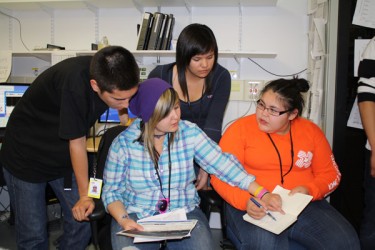Article Origin
Volume
Issue
Year
A group of La Loche students made history last month when they visited the Canadian Light Source Synchrotron.
They made the trip to analyze data obtained from tree core samples — and they were the first people to ever do such an experiment at the synchrotron.
“We know that acid rain is falling on La Loche,” explained Bryan Chappell, Chemistry 30 teacher at La Loche Community School. “That’s been pretty well established. We don’t know where it’s coming from.”
Student Shaedan Klein said it is possible they could learn something new and exciting from the experiment.
“Where the trees are, we’re getting lots of acid rain from the oil sands and we’re just trying to see the effects on it, what new elements we find in the tree cores,” said Klein.
The students were looking for elements like sulphur, titanium and aluminum ions.
Their teacher said the experience is great for his students because they are using much of what they learn in their Chemistry curriculum, as well as developing research skills.
Chappell said water isn’t a huge concern but the rest of the environment is.
“The lakes around northern Saskatchewan are fairly basic, so the acid rain is neutralized. The lakes aren’t turning particularly acidic because of acid rain but maybe there’s an effect on the plants or the soil. The soil around La Loche is very sensitive to acidity,” said Chappell.
Student Jontae DesRoches said there are some concerns in the community of what oil sands in neighbouring Alberta could be doing to La Loche’s wilderness.
“Elders have noticed that the landscape, where trees used to grow, there’s none growing anymore. They’re pretty concerned because wildlife is disappearing. Like, here there used to be rabbits and now there’s none,” said DesRoches.
Klein said acid rain could be detrimental to people’s way of life in La Loche.
“I learned that fish die when the PH level’s 3.5, so they slowly start dying, so there could be smaller amounts of fish. And fish is a big part of culture, because everyone fishes,” she said.
DesRoches said if for some reason, something really earth-shattering was found, the students might try to argue to the Alberta government that “you should slow down with the whole oil sands thing, because all the acid rain is coming over to our province and is affecting wildlife and the environment.”
In the end, the students found a significant amount of sulphur in the tree cores as well as lichen samples, and it was particularly prevalent in the younger parts, both of which are exposed to the environment. Atmospheric sulphur, or acid rain, is a probable source.
Photo caption: L to R: Jontae DesRoches, Shaeden Klein, Jennessa Herman (standing), Tara Janvier-Lemaigre Missing: Nicholas Herman & Dene Cheecham-Uhrich
- 3713 views

